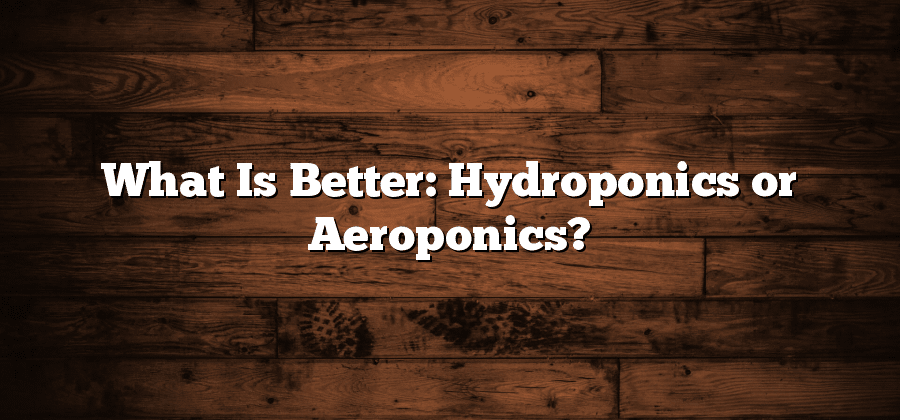Advantages of Hydroponics
The advantages of hydroponics are numerous and have contributed to the increasing popularity of this growing method. Firstly, hydroponics allows for precise control over the growing conditions, ensuring optimal plant growth. With the ability to adjust variables such as nutrient concentrations, pH levels, and light exposure, hydroponic systems provide an ideal environment for plants to thrive.
Additionally, hydroponics eliminates the need for soil, which not only reduces the risk of soil-borne diseases and pests but also allows for space-efficient cultivation. This makes hydroponics a viable option for urban farming and areas with limited land availability. Moreover, water usage in hydroponics is significantly lower compared to traditional soil-based agriculture, resulting in increased water efficiency and conservation.
In conclusion, the advantages of hydroponics, such as precise control over growing conditions and the elimination of soil, make it a popular choice in modern farming. With water efficiency and space-saving capabilities, hydroponics offers a sustainable solution for future food production needs.
Advantages of Aeroponics
Aeroponics, a form of soilless agriculture, offers several advantages that make it an attractive option for growers. One key advantage is its efficient use of water and nutrients. In an aeroponic system, plants are suspended in air and receive nutrient-rich water in the form of a mist or aerosol. This means that water is used more sparingly compared to traditional soil-based methods, as it is precisely delivered to the roots where it is needed most. Additionally, the misting action allows for optimal nutrient absorption by the roots, resulting in higher nutrient efficiency and healthier plants overall.
Another advantage of aeroponics is the ability to grow plants in a controlled environment. Unlike traditional farming methods, which are subject to seasonal changes and weather conditions, aeroponic systems enable year-round cultivation. This level of control allows for the manipulation of factors such as temperature, humidity, and lighting, which can be tailored to specific plant requirements. By creating an ideal environment, growers can optimize plant growth, increase yields, and even manipulate the growing conditions to enhance the flavor, texture, and nutritional content of the produce.
Comparison of Nutrient Delivery Systems
Hydroponics and aeroponics are two advanced systems of growing plants that eliminate the need for traditional soil-based methods. One of the key aspects to consider when comparing these two systems is their nutrient delivery methods. In hydroponics, plants are grown in nutrient-rich water solutions, which are delivered directly to the roots through a variety of systems such as evenly distributed drip systems or nutrient film technique. This ensures that the plants receive the necessary nutrients in optimal amounts, resulting in healthy growth and increased yield.
On the other hand, aeroponics takes nutrient delivery to a whole new level. In this system, plants are suspended in air and the roots are misted with a nutrient-rich solution at regular intervals. This innovative method ensures that the roots receive maximum oxygen and nutrient exposure, leading to faster growth rates and even greater water and nutrient efficiency compared to hydroponics. Additionally, the misting process in aeroponics eliminates the risk of root diseases caused by standing water, further enhancing plant health and productivity.
Water and Nutrient Efficiency in Hydroponics
Hydroponics is a soilless farming method that offers notable advantages in water and nutrient efficiency. Compared to traditional soil-based agriculture, hydroponics uses up to 90% less water while still delivering the necessary nutrients to plants. This is achieved by recycling and reusing the nutrient-rich water solution in a closed system. The controlled environment of a hydroponic setup allows for precise monitoring and adjustment of water and nutrient levels, ensuring optimal plant growth while minimizing waste.
The water and nutrient efficiency of hydroponics not only helps conserve precious resources, but it also reduces the risk of nutrient pollution in surrounding ecosystems. In soil-based farming, excess fertilizers and chemicals can leach into the soil and nearby water sources, causing water pollution and harm to aquatic life. With hydroponics, the closed-loop system prevents nutrient runoff, making it an environmentally friendly choice for sustainable agriculture. By maximizing water and nutrient utilization, hydroponics presents a promising solution to address the challenges of food production in a rapidly growing world population.
Water and Nutrient Efficiency in Aeroponics
Aeroponics, a cutting-edge cultivation technique, has gained attention for its exceptional water and nutrient efficiency. This system far surpasses traditional soil-based methods in terms of resource conservation. By delivering nutrient-rich mist directly to the plant roots, it eliminates the need for excessive watering. This efficient use of water not only minimizes wastage but also reduces the overall water requirements for crop production, making it an environmentally conscious choice.
Moreover, the nutrient efficiency of aeroponics is truly remarkable. The finely atomized nutrient solution allows for optimal absorption by the plant roots, ensuring that each essential element is delivered precisely where it is needed. This precision ensures minimal nutrient loss, as the mist is directly absorbed by the plants without any runoff or leaching. As a result, aeroponics offers high nutrient utilization rates, allowing growers to maximize the benefits of their nutrient inputs. This efficiency is not only economically advantageous but also reduces the potential environmental impact associated with excess nutrient runoff into waterways.






